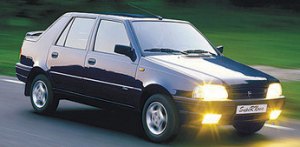
| - |

2017: 655,235 units
2016: 584,219 units
2015: 550,920 units
2014: 511,465 units
2013: 429,540 units
2012: 359,822 units
2011: 343,233 units
2010: 348,723 units
2009: 311,332 units
2008: 258,472 units
2007: 230,483 units
2006: 196,708 units
2005: 164,406 units
 Dacia 1300 (1969)
Dacia 1300 (1969)Since its relationship with Renault terminated in 1978, Dacia kept improving its Renault design by its own effort. In 1995, it finally launched the first car 100% designed by itself, the Dacia Nova. However, this car was quite outdated by the world standards. As Romania was joining European Union, Dacia would not survive the competition in an open market with these products. Therefore in 1999 the government decided to privatize it and sold 50% stakes to Renault. 4 years later, Renault increased its stakes to over 99%, thus Dacia became its full subsidiary.
 Dacia Nova (1995)
Dacia Nova (1995)Taking advantage of the low production costs in Romania, Renault used Dacia to produce its super-cheap "5000 Euro" car, Logan, both for domestic sales and export.